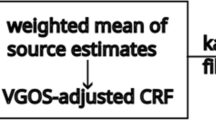Abstract
The geodetic VLBI community began using VLBA antennas in 1989 for geodesy and astrometry. We examine how usage of the VLBA has improved the celestial reference frame, the terrestrial reference frame, and Earth orientation parameters. Without the VLBA, ICRF2 would have had only 1011 sources instead of 3414. ICRF3 will contain at least 4121 sources, with approximately 70 % or more coming exclusively from VLBA astrometry and geodesy sessions. The terrestrial reference frame is also more stable and precise due to VLBA geodesy sessions. Approximately two dozen geodesy stations that have participated in VLBA sessions show average position formal errors that are \(\sim \)13–14 % better in the horizontal components and \(\sim \)5 % better in the vertical component than would be expected solely from the increased number of observations. Also the Earth orientation parameters obtained from the RDV sessions represent the most accurate EOP series of any of the long-term VLBI session types.

Similar content being viewed by others
Notes
A ‘session’ is a continuous VLBI observing run, usually 24 h in length.
An observation is a single baseline delay and rate measurement.
All source position errors given here are ‘inflated’ as was done in ICRF2, by multiplying the formal solution errors by 1.5 and then adding in 40 \(\mu \)-arc-seconds in an RSS sense.
The GSFC X/S catalog is periodically updated and available at http://gemini.gsfc.nasa.gov/solutions/ or by following the links at http://lupus.gsfc.nasa.gov.
Databases for these sessions are available at the three IVS data centers, one being at ftp://cddis.gsfc.nasa.gov/pub/vlbi/ivsdata/db/.
Available at http://astrogeo.org.
References
Beasley AJ, Gordon D, Peck AB, Petrov L, McMillan DS, Fomalont EB, Ma C (2002) The VLBA calibrator survey-VCS1. Astrophys J Suppl 141:13. doi:10.1086/339806
Fey AL, Gordon D, Jacobs CS (editors) (2009) The second realization of the international celestial reference frame by very long baseline interferometry. IERS technical note no. 35. http://www.iers.org/TN35
Fey AL, Gordon D, Jacobs CS, Ma C, Gaume RA et al (2015) The second realization of the international celestial reference frame by very long baseline interferometry. Astron J 150:58. doi:10.1088/0004-6256/150/58
Fomalont EB, Petrov L, McMillan DS, Gordon D, Ma C (2003) The second VLBA calibrator survey: VCS2. Astron J 126:2562. doi:10.1086/378712
Gordon D (2004) VLBA impact on geodesy and astrometry. In: IVS 2004 general meeting proceedings, NASA/CP-2004-212255, pp 351–355. http://ivscc.gsfc.nasa.gov/publications/gm2004/gordon1
Gordon D, Jacobs C, Beasley A, Peck A, Gaume R, Charlot P, Fey A, Ma C, Titov O, Boboltz D (2016) Second epoch VLBA calibrator survey observations: VCS-II. Astron J 151:154. doi:10.3847/0004-6256/151/6/154
Kovalev YY, Petrov L, Fomalont EB, Gordon D (2007) The fifth VLBA calibrator survey: VCS5. Astron J 133:1236. doi:10.1086/511157
Lanyi GE, Boboltz DA, Charlot P, Fey AL, Fomalont EB, Geldzahler BJ, Gordon D, Jacobs CS, Ma C, Naudet CJ, Romney JD, Sovers OJ, Zhang LD (2010) The celestial reference frame at 24 and 43 GHz. I. Astrometry. Astron J 139:1695–1712. doi:10.1088/0004-6256/139/5/1695
Le Bail K, Gipson JM, Gordon D, MacMillan DS, Behrend D, Thomas CC, Bolotin S, Himwich WE, Baver KD, Corey BE, Titus M, Bourda G, Charlot P, Collioud A (2016) IVS observations of ICRF2-Gaia transfer sources. Astron J 151:79. doi:10.3847/0004-6256/151/3/79
Petrov L, Gordon D, Gipson J, MacMillan D, Ma C, Fomalont E, Walker RC, Carabajal C (2009) Precise geodesy with the very long baseline array. J Geod 83:859. doi:10.1007/s00190-009-0304-7
Petrov L, Kovalev YY, Fomalont EB, Gordon D (2005) The third VLBA calibrator survey: VCS3. Astron J 129:1163. doi:10.1086/426920
Petrov L, Kovalev YY, Fomalont EB, Gordon D (2006) The fourth VLBA calibrator survey. Astron J 131:1872. doi:10.1086/499947
Petrov L, Kovalev YY, Fomalont EB, Gordon D (2008) The sixth VLBA calibrator survey: VCS6. Astron J 136:58. doi:10.1088/0004-6256/136/2/580
Acknowledgments
The VLBA is operated by the National Radio Astronomy Observatory, which is a facility of the National Science Foundation, and operated under cooperative agreement by Associated Universities, Inc. I thank Karine Le Bail for SSA time-series analysis of the EOP series and Alan Fey for information on the USNO/NRAO UT1 Intensive sessions. Support for this work was provided through NASA contract NNG12HP00C.




